- What made you decide to return to Japan?
- I was beginning to feel the limits of what I could do as a member of a dance company. The decision to free myself from affiliation with a company came partly from the constraints I felt knowing that nothing new would begin unless I initiated it myself and partly from the desire for the freedom to choose for myself. I had been doing some choreography while I was a member of companies in Europe but there were times when I couldn’t take jobs or, if I did, there would be other constraints on my time. I found myself getting negative in that kind of system, and I knew that wasn’t good for me.
Since I’m Japanese, I decided to give it a go in Japan. Right away I was given a lot of chances to do my work, but I found myself having trouble with the difference between the way Japanese and European audiences’ approach to performance arts. In Japan, it seems that a lot of people don’t go to see ballet, or whatever, purely as art. Rather, they go out of an interest to see some famous performer. Be that as it may, I wanted to show my work as something that I have confidence and experience in, and I trusted that good work would be judged as good work. But I began to feel a gap between what I wanted to show and how my dance was being seen. It was in the midst of such circumstances that I got the offer from Niigata. - What are your aspirations with regard to the public dance company you have established in Niigata?
- I want as many people as possible to appreciate and enjoy the fact that the new Niigata company Noism is creating works in Niigata and sending them out to the rest of the country. Tokyo is the important market, and if we are recognized there our opportunities will grow, but that won’t make things any easier for us in Niigata. There are a number of things we have to do to get our work appreciated by the (Niigata) public.
- Do you feel that there is a difference between what the public here (in Niigata) will appreciate and what is appreciated in Europe?
- I naturally have confidence in my ability to express myself (in dance) in advanced centers of dance like Tokyo and Europe. There may be times of discouragement, but that is something that anyone involved in creative activity has to work through, and I am confident of my ability to work through those times. Rather, what I am telling myself now is that I must not forget Niigata.
- To begin with, you have a 3-year contract as artistic director. How involved will you be in the management side?
- We are planning to bring out two Noism productions a year. As artistic director I will be responsible for other dance programs as well, but given the limitations of budget it will be difficult to do a lot.
For me, the time I spend creating works in the studio is precious time, the time when I am happiest. But, in order to get that time, there is a lot I have to do outside the studio. When I decided to take on the job of artistic director, I told the people in Niigata that I was fully aware of the responsibilities I would have outside of creating my own new works. Now that we have created this unprecedented public dance company, I know that there is a lot of communicating we have to do, and I’m prepared to do it. And, I imagine that it will take about three years to lay the necessary groundwork. - What is it like working with Japanese now?
- The biggest difference since coming back to Japan is being able to work in Japanese. Being able to use my mother tongue has given me the ability to express my thoughts in words. In working up the choreography for a new piece, I find that my mind functions more clearly in the process of putting together what I want to say in a piece, and I am now able to dig deeper when putting it all in words. When I was in Europe, I never really studied English properly. I tended to just learn things in terms of images, and dance pieces also remained in the realm of image.
Since choreography is a process of looking into myself, now that I have begun to think in Japanese, I believe I will continue to think out my works in Japanese from now on, no matter who I am working with. But, that is not to say that I have begun to have any strong ideas about anything like a Japanese identity within myself. It is just something on the DNA level. - With Noism are you aiming to build an European type company system?
- Even within European dance companies there are several different types of systems. I want to take the best aspects of the companies I worked in and apply them to Noism. As my goal for these first three years, I want to see this become a company that came proudly say three years from now that they are functioning as a professional company in Niigata. And, I want to establish a system by then that other cities wanting to create public dance companies can look to as a model. I don’t know when it will be, but I also want to create a dance school. I learned a lot when I went to study at Béjart at the age of 17, and I would like to make some changes at the (dance) education level. In my day, you simply had to go abroad if you wanted to make your way as a professional dancer. I would like to contribute to create an environment in Japan where young people can practice and pursue their professional career.
- What about your company’s repertoire?
- I don’t want this to be a company that performs only my pieces, as if my choreography is the best. First of all, there are many masterpieces which I would like to present in Japan. I want our dancers to experience these works and I want the Japanese audience to see them. I am also thinking about inviting outside choreographers to come in and do pieces for our company. In the near future I want to commission some Japanese choreographer to do a piece for our company. There are also a lot of very talented choreographers of my generation that I know overseas and would like to bring to Japan someday to do works with here. I know some choreographers that I think are doing the most vivid work today and if I could bring them to Japan I would like to participate as a dancer myself in their works. I want to build a repertoire of pieces that we could say were made possible because such outside choreographers came and worked with the company Noism.
- What about being both a dancer and a choreographer?
- I want to continue to do both, but for now I am concentrating on choreography. I still want to dance, but when you are thinking about your own dance it becomes enough just to think about yourself and you can become egotistical in the process. This is not a time for egotism. This is a time when I must focus my full attention on the dancers I have chosen and what I want us to create. I think that once Noism has really established itself as a company my desire to perform again as a dancer will become stronger.
- What kind of dancers do you want to nurture?
- The first requirement of dancers from now on is that they be able to create movement by themselves. This is absolutely necessary. Dance will continue to evolve very rapidly and new concepts and subject matter will emerge one after another. So, it is not enough to set your sights only on what is already out there on the dance scene now. Being a professional dancer means being a dancer who is already thinking about the newest issues before you are asked to. I think this is a consciousness that is lacking in many Japanese dancers today. It is difficult because most of these dancers have been brought up in a system where it is enough to do what you are told by your teacher, and if you try something new you are liable to be scolded. But I hope people will start to realize soon that this is not enough.
A professional dancer is one who has his or her own unique identity, one that is not interchangeable. I want our dancers to become dancers who have a character of their own that is strong enough to inspire a choreographer to choreography in a way that brings out that character during the creation of a piece. This kind of creation is a process of give and take, and the choreographer wants to receive that kind of stimulation from the dancers. And, it is this kind of unique strength or character for which the dancers are chosen when casting for a creative piece. If you are going to create a piece that only contains the things you already have within yourself, you should be doing it by yourself, solo. At the same time, I want to give things to the dancers, too. And I believe that when you have this kind of two-way give and take, it is the ideal situation for creation.
Connecting this to the question of repertoire, I also want our dancers to be ones who can perform in a number of different types of dance. There are many different ways that the body can be used in dance. When we invite outside choreographers to come in and work with our company they may be ones who are interested in a different type of body movement from mine. When that happens, I want our dancers to be the type who can adjust and absorb new things from the choreographer and receive new inspiration. - What about music?
- There are often cases when I hear some music and am inspired to choreograph to it. The Adagietto of Mahler’s 5th Symphony is a work that I was attracted to the first time I heard it. Later when I saw a pieced that Béjart had choreographed to Mahler’s Adagietto, I had reservations about it. The initial impact of the music was still strong in my mind, so I decided to try choreographing my own piece to it. It came together very quickly and the product was my piece “Under the Marron Tree.”
Ryoji Ikeda is another artist I like, and I am fortunate to have been able to use a lot of his music, including original pieces he composed for my work. For black ice, Atsuhiko Gondai composed the music. This time, the piece he sent me after discussing the kind of music I wanted is really a wonderful piece, and although it was not composed originally for my work, I said I wanted very much to use it and he agreed.
I decide on music intuitively. When I am looking for music to choreograph to I listen to a lot of work, but really listening to music in that way can be tiring, so I don’t usually listen to music in my free time. - With “SHIKAKU” you collaborated with an architect and with “black ice” it was a contemporary artist. Do you plan to continue such collaborations?
- When I think about where contemporary dance is headed, I believe that collaboration with artists from various fields is absolutely essential. Dance is becoming a more comprehensive art form and for a number of years now there have been collaborative works bringing in theater and art, and new things are happening musically as well. What you can gain from working on a collaboration with a new artist is tremendous. However, you have to be careful, because it will not always lead to a successful work.
For me, collaboration is a searching process within the creative process, and it is in the process of discovering new possibilities and then breaking them down that your form of expression is born. The work “SHIKAKU” was the product of a collaborative effort with the architect Tsuyoshi Tane, and we had very interesting conversations about how an architect perceives spaces and the human body. Even in our discussion in areas not related to dance, the time I spent with him was very stimulating.
Jo Kanamori
Artistic Director — Jo Kanamori (29) talks about the future of Japan’s first public dance company.
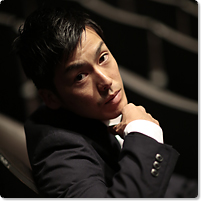
Photo: Kishin Shinoyama
Jo Kanamori
dancer, choreographer/Dance Company Noism
Born in 1974, Kanamori was taught from childhood by his father, Sei Kanamori. His talent was recognized while a member of the Maki Asami Ballet Company and he became the first Japanese dancer to study at the Maurice Béjart’s Rudra Béjart Lausanne. Since then he has been active in Europe with companies like the Netherlands Dance Theatre II. Returning to Japan in 2002, Kanamori produced his first independent production in 2003, titled no•mad•ic Project, for which he won double awards, the Performing Arts Prize of the Asahi Performing Arts Award and the Kirin Dance Support Award. As of 2004 he assumed the post of artistic director for the dance division of the Niigata City Performing Arts Center “Ryutopia.”
https://www.jokanamori.com/
We interviewed Jo Kanamori on September 1st during a break in rehearsals for his production “black ice” at the Niigata City Performing Arts Center.
Interviewer: Yoko Shioya
Noism04
In 2004, Niigata City Performing Arts Center “Ryutopia” welcomed Jo Kanamori as art director of its dance division and subsequently established Japan’s first full-fledged public contemporary dance company, “Noism 04.” Ten dancers were selected for the company from nationwide applicants and are now performing as resident dancers in Niigata. The company performed its first production, SHIKAKU, in June and its second, “black ice” in October.
Niigata
City Performing Arts Center “Ryutopia”
Opened: Oct. 1998
This culture complex built by the city of Niigata includes a concert hall (1,900 seats), a theater (900 seats) and a Noh theater (380 seats). Ryutopia is administered by the Niigata Municipal Foundation for the Promotion of Arts and Culture as one comprehensive facility along with the adjoining Niigata Municipal Music Culture Center, which includes specialized music practice rooms and a performance hall. The Center’s theater division is led by the producer Hiroshi Sasabe as art director, with the director Yoshihiro Kurita serving as associate director. The art director for the dance division is Jo Kanamori. The total annual budget for the Center is about 400 million yen. The Music division has a Junior Orchestra for young students of music which is based at the Music Culture Center and it also operates a music school for elementary and middle school students and produces original musicals. The Center also creates original productions to tour Japan and has presented a Shakespeare series at its Noh theater featuring famous quest actors.
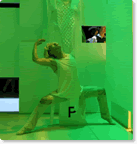

SHIKAKU
Premiere: June, 2004
This work is the product of a collaborative effort with the young architect, Tsuyoshi Tane, the musician Masahiro Hiramoto and others. The title, when written as it is in Roman letters can have various meanings in Japanese, ranging from a rectangle, a visual angle, a blind spot, a poet and a writer to an assassin, qualifications, poetic form, the sense of sight and enlightenment. This is an experimental piece in which the stages is divided at first into four chambers by white walls. As the dancers move in and out of the chambers, the audience is also free to walk around the stage viewing the performance from different angles. There are also ffective special manipulations such as the partitions being raised during a blackout of the stage lighting to produce one large, flat open space. For the duration of the piece the dancers move ceaselessly, playing out the various meanings harbored in the word shikaku: “There are walls and then there are none;” “Now you see, now you don’t;” “Now it is shown, now it is not” and “Now things can be communicated, now they can’t.”
©Niigata City Performing Arts Center
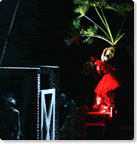
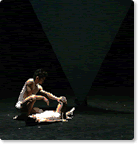
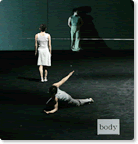

black ice
Premiere:October, 2004
This is a collaborative work with the contemporary artist Tadasu Takamine. The term “black ice” used in the title refers to a completely transparent ice and the expression comes from the appearance of black asphalt showing through a completely transparent film of ice on a road. The term is used figuratively to mean something that can’t be seen but still has an effect, as when a car slips on the unseen film of ice on the road. The production is an omnibus work consisting of three short pieces, each of a different type: black wind, which takes as its text a man facing imminent death, staged against a backdrop of video art by Takamine; “black ice”, which is a collaboration on the theme of points of contact (with the ground) involving dancers and special images created with the use of a thermograph; and black garden, in which the dancers search the depths of their own souls in a forest-like array of objet. This work also displays effective manipulations of the stage space such as creating a complete “black box” by spreading a black stage cloth on the floor which is usually never used in dance because of its slippery quality.
Related Tags

